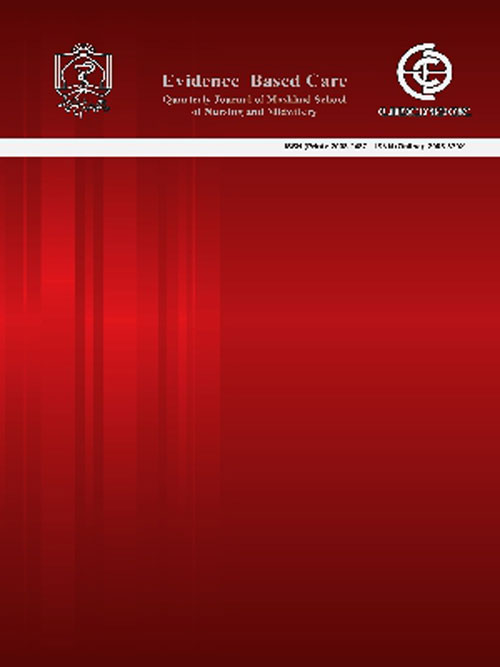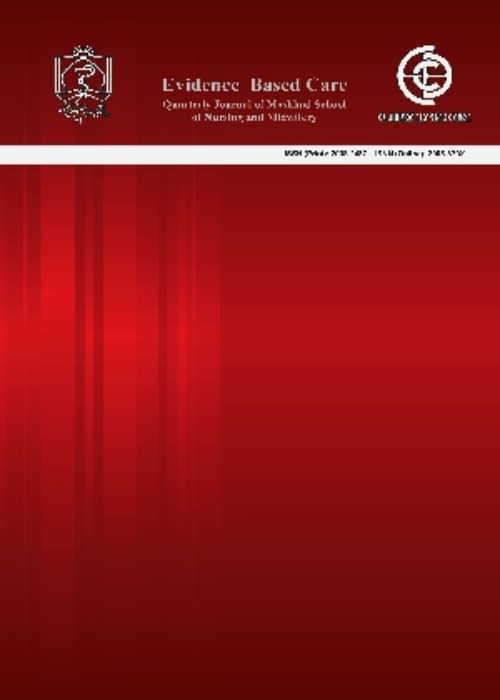فهرست مطالب

Evidence Based Care
Volume:12 Issue: 2, Summer 2022
- تاریخ انتشار: 1401/04/23
- تعداد عناوین: 8
-
-
Pages 7-16BackgroundHome care is always appreciated as an effective alternative method to manage critical conditions, expand hospital capacity, and admit further cases suspected of more severe clinical symptoms.AimThe present study aimed to reflect on the experiences of in-home caregivers of patients with coronavirus disease 2019 (COVID-19) in Iran.MethodFor this qualitative descriptive study, 13 participants (i.e., the Iranian family caregivers of patients with COVID-19) were selected and included using the purposive sampling method. Caregivers were those who accompanied the patient to the outpatient department for three months from 22 June to 22 August 2021. An interview was conducted in a private room with family caregivers of patients. The data were obtained through a series of semi-structured interviews, each one lasting 30-40 min. The data were completed via the MAXQDA software (version 10). Analysis was performed according to the approach of Granheim and Landman 2004 by the conventional content analysis method.ResultsThe results lead to the emergence of the final theme "vigilant care" containing four categories (e.g., Quarantine fence, Economic management as a bottleneck, Confusion and difficulty in care, as well as Conflicting adaptation and mitigation of psychological stress) and 14 subcategories.Implications for Practice: Vigilance care is a major challenge for caregivers of patients with Covid-19 at home. Therefore, providing educational solutions or training booklets in outpatient wards during discharge can partially resolve the ambiguities and be effective in improving care.Keywords: Caregivers, COVID-19, Home nursing, Qualitative study
-
Pages 17-23BackgroundWith rapid outbreak of coronavirus disease 2019 (COVID-19), due to high transmission, long incubation, rapid spread and lack of definitive treatment of disease, extensive efforts were simultaneously made to identify the transmission chain and ways to control the disease.AimThis study aimed to accurately identify help seeking behaviors during Covid-19 pandemic.MethodThis qualitative study was performed based on explanatory model of Kleinman’s theory and through semi-structured interviews with 15 individuals who were confirmed as COVID-19 cases in Tehran. Interviews were conducted by telephone, digitally recorded and transcribed verbatim and analyzed via directional content analysis based on Graneheim and Lundman. Help seeking behaviors in different levels were extracted by purposive sampling approach.ResultsThree main categories were extracted including popular, professional and folk sectors in help seeking behaviors. In popular sector, four levels were extracted consisting of individual, familial, social and community. In individual level, phone consultation and self-medication were two main subcategories. In familial level, conflict of expectation and the key role of wife in Covid-19 management were expressed. In social level, three subcategories included donors / charity, media and social media. Community level had one subcategory named ethical commitment. In professional sector, three subcategories were extracted including training, medical insurance and emergency services. In folk sector, the majority of participants believed that Covid-19 is God's punishment for people's sins.Implications for Practice: Exploring help-seeking behaviors at different levels can help the national health system to better control COVID-19 pandemic and provide preventive services.Keywords: Coronavirus, Qualitative study, Content Analysis
-
Pages 24-31Aim
This study was performed aimed to compare the effect of isometric exercises and lidocaine 2% on pain relief during intravenous propofol injection.
MethodThis randomized clinical trial (RCT) study was performed in 2020 on 106 patients who were candidates for general anesthesia for different surgical treatments in Neyshabur 22 Bahman Hospital. The subjects were randomly allocated into three groups by permuted block randomization. Group A received propofol 1% with 40 mg lidocaine 2%, group B received pure propofol 1%, and group C completed 5 cycles of isometric exercises before injection of 1% pure propofol. Data collection tools consisted of a demographic information questionnaire and Ambesh four-point scale. Data were analyzed by SPSS software (version 16) and Fisher’s exact test, Mann-Whitney U test, and analysis of variance (ANOVA). P<0.05 was considered statistically significant.
ResultsThe majority of patients underwent general surgery. There was no significant difference between pain intensity in groups A and C, but group B reported significantly higher pain intensity than the intervention groups (P<0.001).Implications for Practice: The use of both lidocaine 2% and isometric exercises reduces the pain intensity of propofol injection. Therefore, the use of these two methods is recommended.
Keywords: Intravenous injection, Isometric exercises, Lidocaine, Pain, Propofol -
Pages 32-40BackgroundThe side effects of long-term use and high doses of drugs have increased the use of complementary therapies for the reduction of pain.AimThe present study aimed to compare the effect of foot reflexology and gentle stretching exercises on pain intensity in patients after spine surgery.MethodThis clinical trial study was performed on 90 patients undergoing spinal surgery referring to hospitals affiliated to Mashhad University of Medical Sciences in 2019. Patients were randomly assigned to three groups: foot reflexology, gentle stretching exercises, and control. In intervention groups, apart from the routine procedures, foot reflexology or gentle stretching exercises were performed daily from the first day after surgery until discharge, and also three times a week for six weeks after discharge. In the control group, only routine care was performed.ResultsThe mean age of the samples was 43.35±11.15 years. In within-group comparison, the mean pain intensity was significantly decreased at the end of the sixth week after surgery in all three groups (P<0.001). The mean of pain intensity in the reflexology group was lower than that in the stretching exercise group on the second day after surgery, discharge time, as well as the first and sixth weeks after discharge (P<0.001). Nonetheless, there was no significant difference between the stretching exercise group and the control group (P<0.05).Implications for Practice: Foot reflexology effectively reduces the pain intensity of patients after spinal surgery. Therefore, it is recommended to be performed by patients or their caregivers to reduce pain after spinal surgery.Keywords: Foot reflexology, Pain, Spine Surgery, Stretching Exercises
-
Pages 41-50Background
In previous studies, the anesthesia technique was performed by different people and different results were reported, which makes comparisons difficult.
AimThis study aimed to compare Sprotte (Non-cutting) and Quincke (Cutting) spinal needles on the frequency of spinal anesthesia success in patients undergoing cesarean delivery.
MethodThis double-blind randomized clinical trial study was performed in 2019 on 100 pregnant women in ASA class I or II with term and single pregnancies who were candidates for elective cesarean section with spinal anesthesiain Tabriz Al-Zahra Hospital. Spinal anesthesia was performed using Sprotte spinal needle 25G in the intervention group (n=50) and with Quincke's spinal needle 25G in the control group (n=50). The frequency of spinal anesthesia failure was recorded as complete and partial failure. Data were analyzed using SPSS.16 software. P<0.05 was considered statistically significant.
ResultsIn the Sprotte group, there was one patient with incomplete failure and two with complete failure; in the Quincke group, there were 2 patients with incomplete failure and 3 with complete failure; the two groups were not significantly different (P=0.749). Three patients in the Quincke group required repeated spinal block. The frequency of sensory (P=0.002) and motor (P=0.001) block for surgery was significantly higher in the Sprotte group. The Post-Dural puncture headache (PDPH) was significantly higher in the Quincke group (P=0.006). Implications for Practice: The Post-Dural puncture headache (PDPH) using Sprotte spinal needle was lower than using Quincke needle in patients with spinal anesthesia for cesarean delivery.
Keywords: Cesarean delivery, Spinal anesthesia, Failure, Sprotte, Quincke -
Pages 51-56BackgroundMedical adherence is critical to hypertension treatment. Medication non-adherence is one of the problems affecting hypertensive patients. Belief in health treatment is very important to support adherence behavior, especially in hypertension.AimThe present research aimed to determine the relationship of the health belief model with medical adherence and risk factor prevention in hypertension patients.MethodThis cross-sectional study was conducted on patients referring to health centers in Cimahi City, Indonesia, in 2020. A total of 180 patients were selected via the purposive sampling method. The instrument used to measure medical treatment adherence and risk factor prevention was the Hill-Bone Compliance to High Blood Pressure Therapy Scale. The data were analyzed in SPSS Software using the Chi-square test and Logistic regression test.ResultsThe majority of participants were female (88.9%), unemployed (76.7%), within the age range of 40-59 years (60.0%), and had low education (75.0%). Moreover, most cases had health insurance (91.7%), with a maximum duration of hypertension less than 5 years (70.6%), and a body mass index (BMI) between 18.5-25.0 (45%). The health belief model was related to adherence to hypertension treatment (P<0.05); nonetheless, in the multivariate model, the perceived benefit had no significant relationship when entering into the regression model. Implications for Practice: To improve medication adherence and risk factor prevention in hypertensive patients, it is necessary to strengthen the health belief model with continuous and ongoing education about hypertension.Keywords: Health belief model, Hypertension, Medical adherence
-
Pages 57-65BackgroundDespite progress in reducing HIV-related mortality over the past decade, the prevalence and incidence of HIV infection slightly decreased. Nursing profession as a part of the health care system is most affected by HIV/AIDS. HIV-positive nurses need more support from governments and officials. Little is known about how Iranian HIV-positive nurses experience their life situations.AimThis study evaluated the experiences of HIV-positive nurses and their attempts to manage HIV/AIDS in personal and occupational livings.MethodThe hermeneutic phenomenological approach developed by van Manen's methodology (1990) was adopted to explore the experience of daily life for HIV-positive nurses. A purposive sampling of eight HIV-positive nurses was recruited. Face-to-face in-depth interviews were conducted with two female and six male nurses who had infected with HIV via occupational exposure. Data were analyzed using thematic analysis.ResultsThe experiences of HIV-infected nurses derived in one major theme and three subthemes. Major theme “living in the blurry world” extracted from three sub-themes: ‘being-in-the-risky world’, ‘being-in-the-shadow of illness’, and ‘ambiguous being-in-the-world’. Implications for Practice: HIV positive nurses perceive the world full of fear and ambiguities. They prefer to suffer in silence and reluctant to disclose their seropositive status. The results of this study can be used by professionals to better understand the HIV positive nurses' world and make more efforts to improve their workplace experiences and reduce stigma in the future.Keywords: Hermeneutics, HIV Infection, Iran, Needle stick Injuries, Nursing staff, Qualitative research, Social Stigma
-
Pages 66-75Background
Endotracheal extubation is associated with high complications such as sore throat, cough, and hoarseness.
AimThis study was performed aimed to compare the effect of green tea and licorice gargle on sore throat, cough, and hoarseness after endotracheal extubation.
MethodThis randomized controlled clinical trial was performed in the operating rooms and surgical wards of two hospitals in Tehran during 2020-2021. A total of 102 candidates for elective surgery were allocated to licorice, green tea, and control groups by simple random allocation. The scores of sore throat, cough, and hoarseness were assessed one hour after endotracheal extubation. After the gag reflex returned, 30 cc of the prepared solutions was given to the patients to gargle for 30 seconds. The intervention was repeated two hours later. The scores were assessed in the three groups immediately after the first stage of the intervention (post test1), and two hours after the second stage of the intervention (Post-test 2). Data were analyzed by SPSS software (version 16) and One-way Analysis of Variance-ANOVA, Repeated Measure ANOVA and post hoc test. P<0.05 was considered statistically significant.
ResultsThere was significant difference between the three groups regarding sore throat, cough, and hoarseness variables in the post-test 1 and post-test 2 stages (P<0.05). The intervention groups had significantly reduced scores in three main variables compared to the control group (P< 0.05), but the difference between the two intervention groups was not significant (P> 0.05). Implications for Practice: Gargle of licorice solutions or green tea is recommended as a non-pharmacological and low-cost intervention to reduce post-extubation complications.
Keywords: Cough, Green tea, Hoarseness, Licorice, Sore throat


